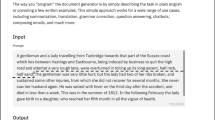Abstract
Forty-eight children and forty-eight adults of contrasting degrees of expertise made a series of corrections in order to improve a text (narrative or description) in which three within-statement errors and three between-statement errors had been inserted. Subjects used a simplified word processor (SCRIPREV) which recorded all movements of linguistic units.
The purpose of this research was to study revising strategies by examining the correction-sequencing procedures implemented by these subjects. The procedures, which were coded in the form of time series, were compared to the time series of model revising procedures (i.e. effective ones) representing three strategies based on certain predefined functional principles (linguistic level, execution order).
The adults used two of these strategies: the Simultaneous Strategy for the narrative, and the Local-then-Global Strategy for the description. The children used the Local-then-Global Strategy for the narrative, but did not use any identifiable procedure to revise the description, which they did not manage to totally improve in the expected manner.
Similar content being viewed by others
References
Bartlett, E. (1982). Learning to revise: Some component processes. In M. Nystrand (Ed.), What writers know: The language process and structure of written discourse, (pp. 345–364). New York: Academic Press.
Collier, R. M. (1983). The word processor and revision strategies. College Composition and Communication, 34, 149–155.
Daiute, C. (1989). Play as thought: Thinking strategies of young writers. Harvard Educational Review, 59, 1–23
Faigley, L., & Witte, S. (1981). Analyzing revision. College Composition and Communication, 32, 400–414.
Fayol, M., & Gombert, J. E. (1987). Le retour de l’auteur sur son texte: Bilan provisoire des recherches psycholinguistiques. Repères, 73, 85–95.
Flower, L., & Hayes, J. R. (1981). A Cognitive Process Theory of Writing. College Composition and Communication, 32, 365–387.
Flower, L., Hayes, J. R., Carey, L., Schriver, K., & Stratman, J. (1986). Detection, diagnosis, and the strategies of revision. College Composition and Communication, 37, 16–55.
Guercin, F. (1986). Proposition de logiciel pour le traitement des chroniques. Congrès Annuel de la S.F.P. (section de Psychologie Expérimentale), Aix-En-Provence, 13–14 Mars.
Guercin, F., Roussey, J. Y., & Piolat, A. (1990). Time series: A tool for analyzing complex cognitive activities. Application to the study of text revising strategies. C.P.C./European Bulletin of Cognitive Psychology, 1, 79–110.
Hayes, J. R., Flower, L. S., Schriver, K., Stratman, J., & Carey, L. (1987). Cognitive processes in revision. In S. Rosenberg (Ed.), Reading, writing, and language learning Advances in applied psycholinguistics, Vol. II, (pp. 176–240). Cambridge: Cambridge University Press.
Kurth, R. J. (1987). Using word processing to enhance strategies during student writing activities. Educational Technology, January, 13–19.
Mc Cormick Calkins, L. (1980). Notes and comments. Children’s rewriting strategies. Research in the Teaching of English, 14, 331–341.
Matsuhashi, A., & Gordon, E. (1985). Revision, addition, and the power of the unseen text. In S. W. Freedman (Ed.). The acquisition of written language: Response and revision, (pp. 226–249), Norwood, N.J.: Ablex.
Piolat, A., & Roussey, J.-Y. (in press). A propos de l’expression «stratégie de révision» de textes en psychologie cognitive. Textes en Main.
Piolat, A., Roussey, J.-Y., & Farioli, F. (1987). Révision de texte par l’enfant et l’adulte en production assistée par ordinateur. Bulletin d’Audiophonologie, 3, 733–748.
Piolat, A., Roussey, J.-Y., & Guercin, F. (1989). Text revising strategies. In P. Boscolo (Ed.), Writing: Trends in European Research, (pp. 12–20), Padova: U.P.S.E.L. Editore.
Roussey, J.-Y., Piolat, A., & Guercin, F. (1990). Revising strategies for different text types. Language and Education, 4 (1), 51–65.
Scardamalia, M. & Bereiter, C. (1985). Fostering the development of self-regulation in children’s knowledge Processing. In S. F. Chipman, J. W. Segal & R. Glaser (Eds.), Thinking and learning skills. Research and open questions, (pp. 563–577). Hillsdale, N.J.: L.E.A.
Author information
Authors and Affiliations
Additional information
The experiment reported in this article was conducted at the Centre de Recherche en Psychologie Cognitive, a research unit affiliated with the Centre National de la Recherche Scientifique, France.
Rights and permissions
About this article
Cite this article
Piolat, A., Roussey, JY. Narrative and descriptive text revising strategies and procedures. Eur J Psychol Educ 6, 155–163 (1991). https://doi.org/10.1007/BF03191934
Received:
Published:
Issue Date:
DOI: https://doi.org/10.1007/BF03191934



